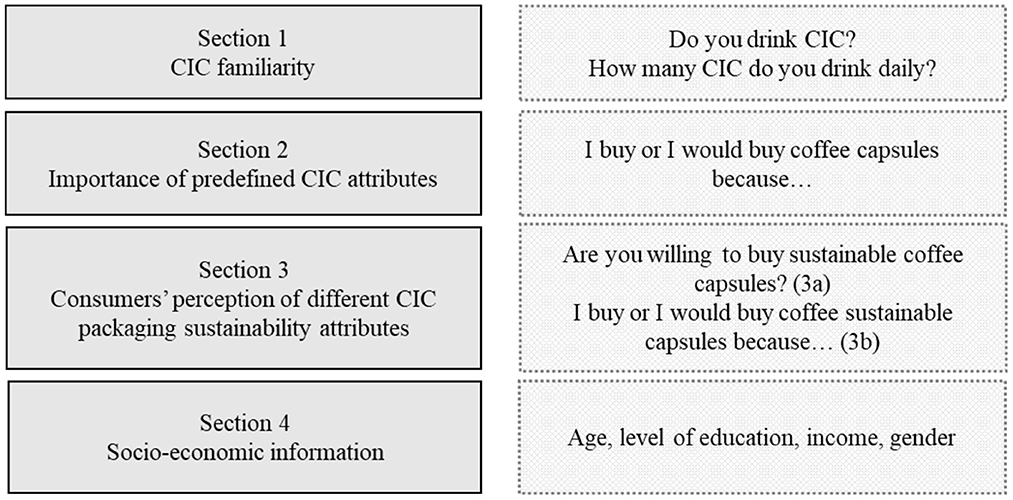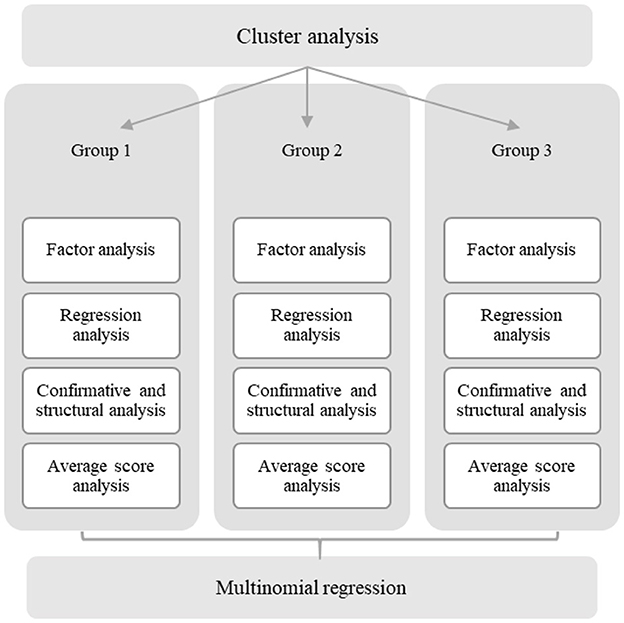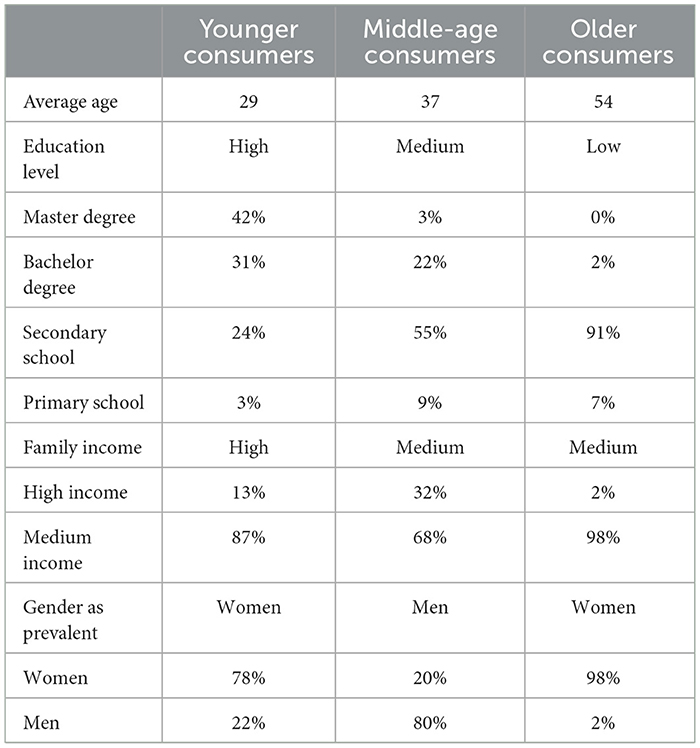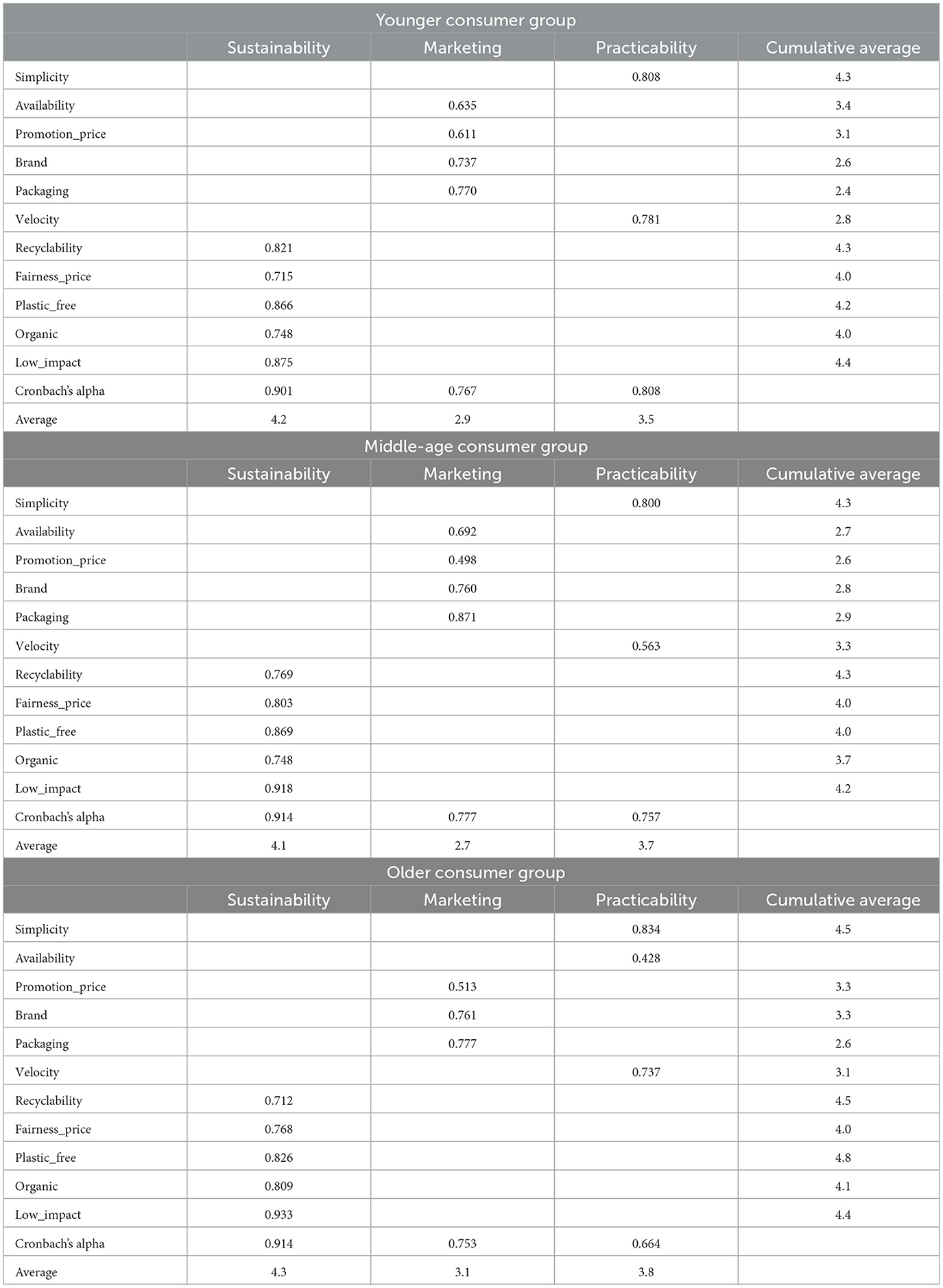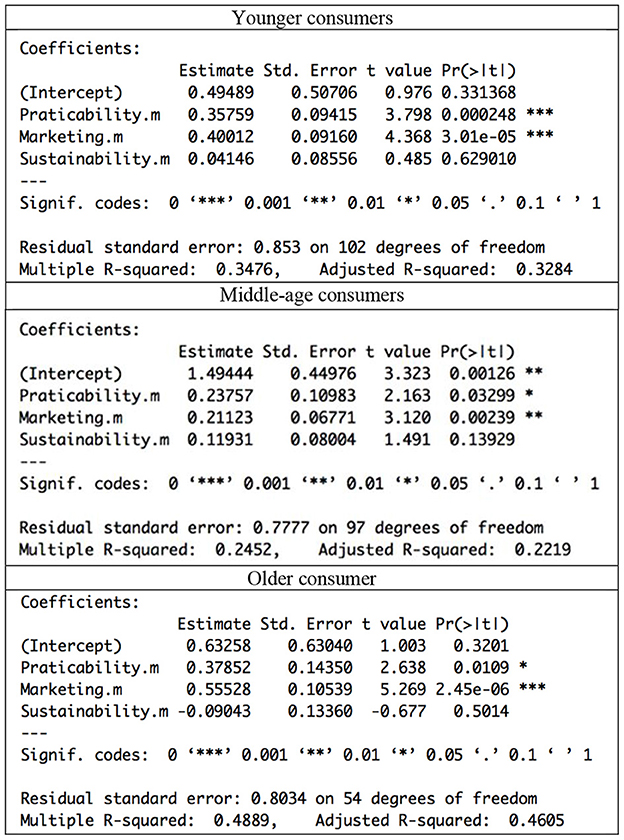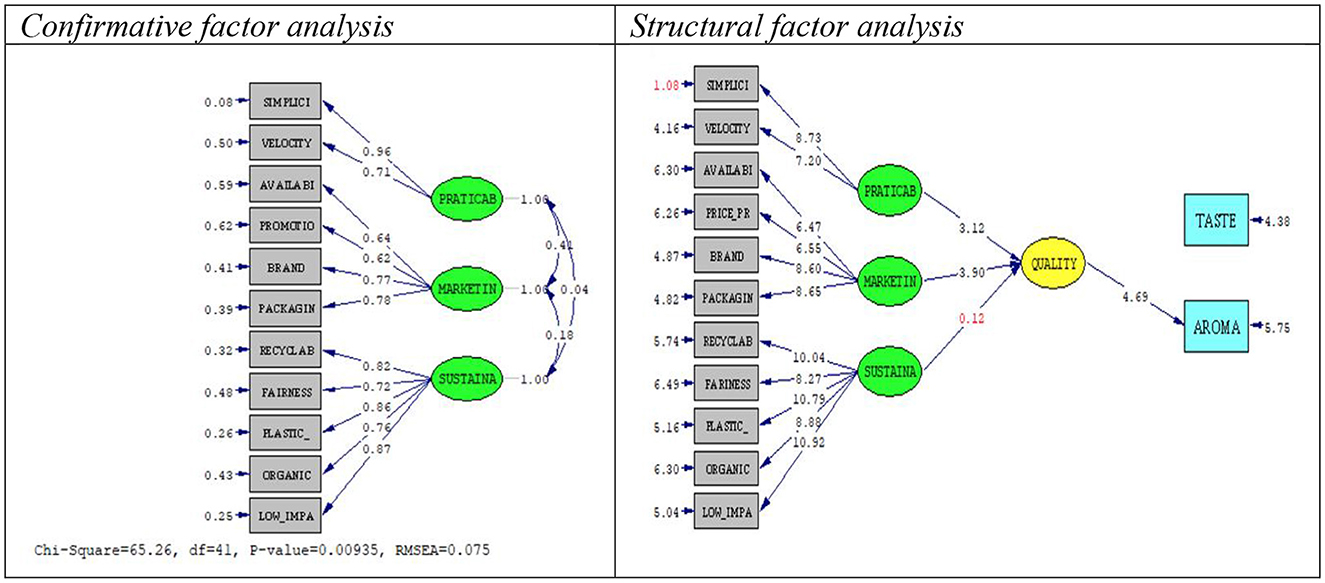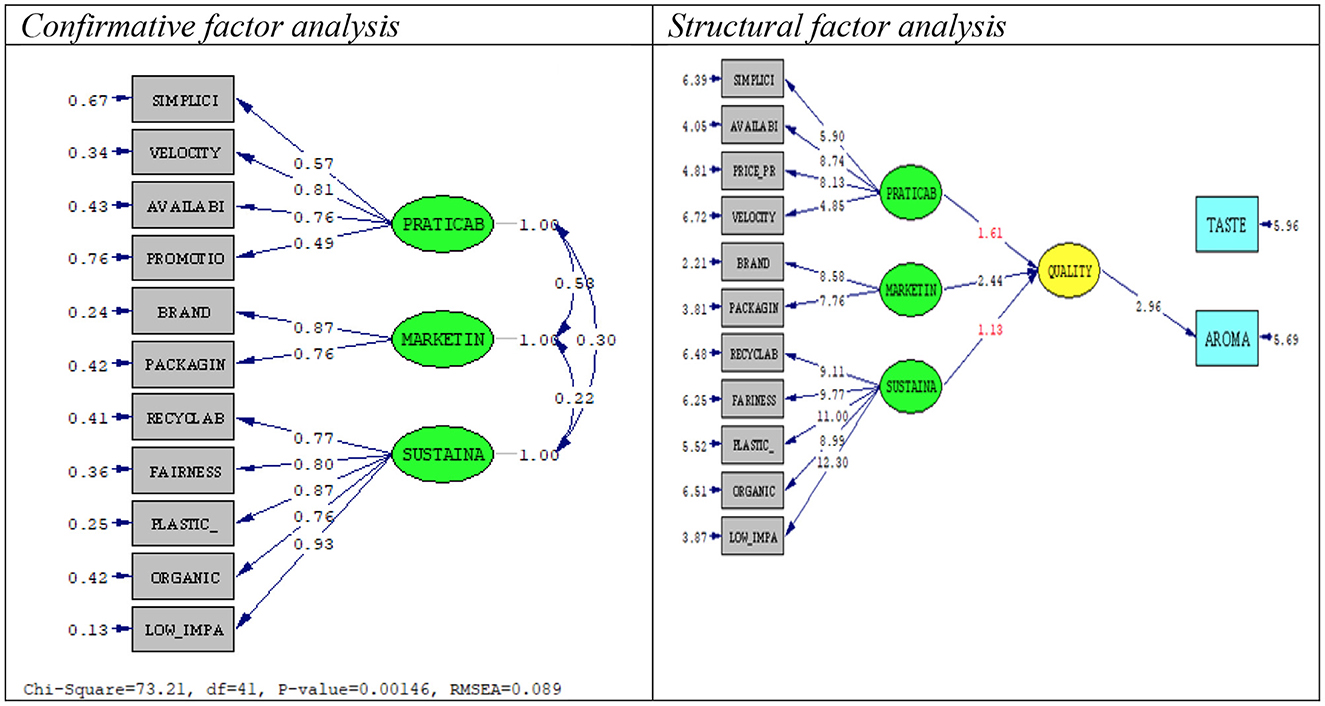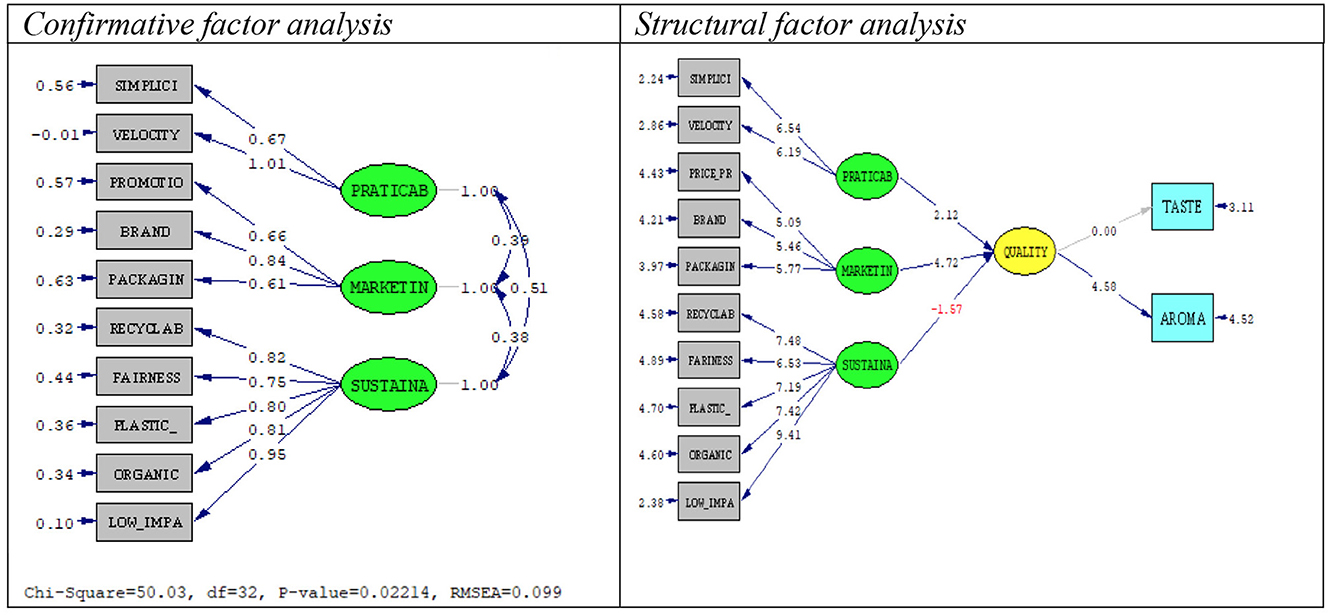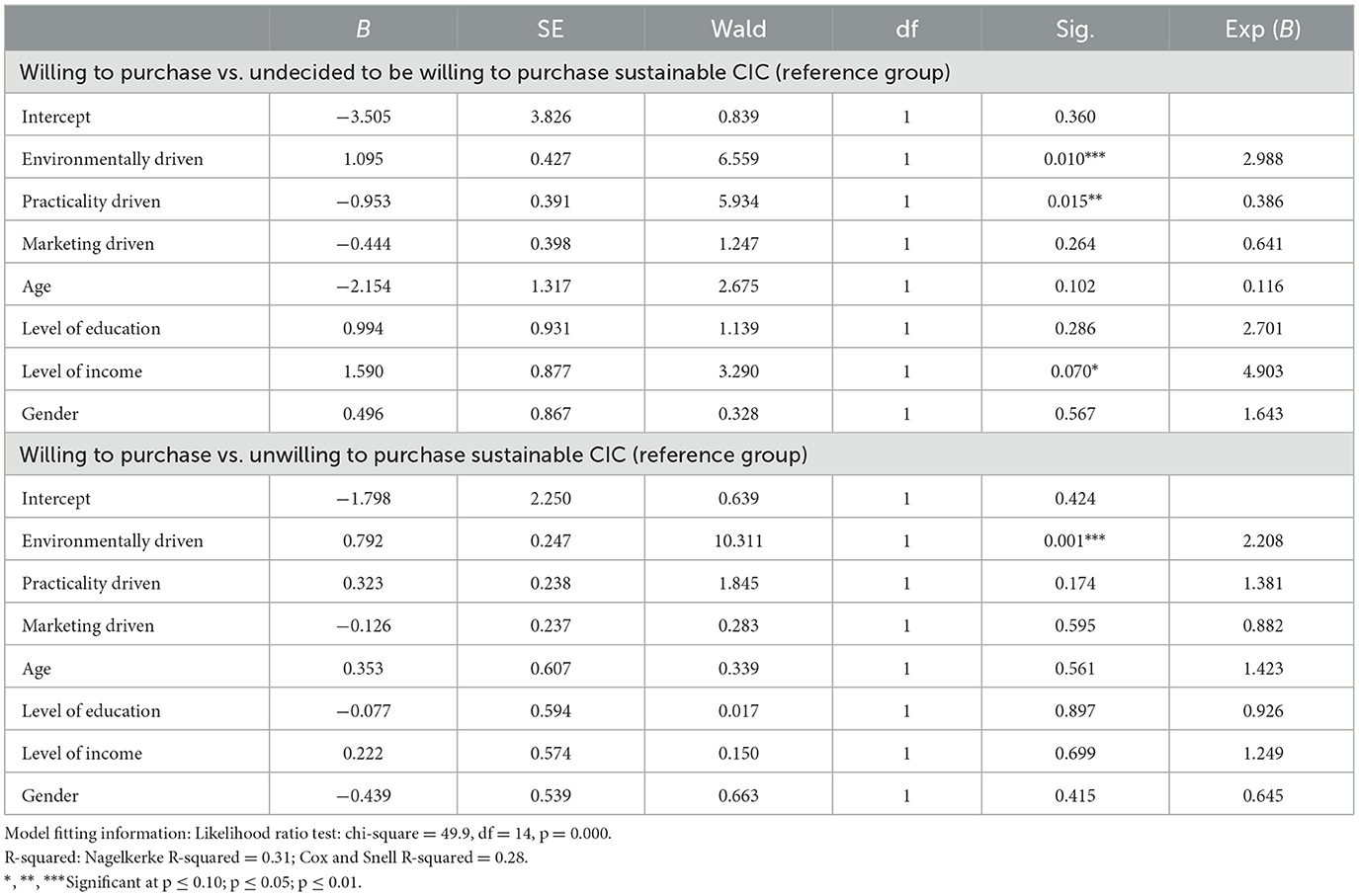- Department of Agricultural and Food Sciences, University of Bologna, Bologna, Italy
Introduction: Coffee is among the most appreciated beverages by consumers globally. Single serve coffee market expands and is highly profitable, but coffee in capsules (CIC) raises a major issue of environmental sustainability. The coffee industry aims to expand the CIC sales and to reduce capsule environmental impact and waste. To better define a sustainability-oriented strategy, the coffee industry needs to understand how to approach different socio-economic consumer groups. Thus, this study aims to explore consumers' perception and awareness of sustainable CIC, with specific attention on consumers' socio-economic characteristics.
Methods: The study interviewed a sample of 261 Italian consumers. Data elaboration includes four main steps: a cluster analysis leading to three socio-economic groups, a factor and structural equation modeling to confirm the factors and the relation between CIC sustainability and quality factors, and a multinomial logistic regression to examine the factors that drive the likeliness of consumers' willingness to purchase sustainable CIC.
Results: Results support that all groups of consumers value sustainability attribute as main CIC purchasing decision driver. The sustainability factor does not show any significance on the explanation of the CIC quality factor. Consumer perception of the CIC sustainability is not affected by age, income, level of education, and gender.
Conclusion: This study provides preliminary insights for sustainable CIC production and consumption.
1. Introduction
Coffee is among the most consumed beverages in the world. Consumers can choose products from a wide variety of coffee products and consumption occasions. The current coffee consumption behavior is driven by three elements: pleasure, health and sustainability. Over the last decades, coffee has evolved from a pure commodity to a specialty product, passing through the so-called “three waves of coffee consumption” (Manzo, 2014). The first wave, at the end of the 19th century, consisted of converting coffee into an industrial good, mainly managed by Brazil and the United States coffee industry. In the 1990s, with the second wave, coffee became a specialty beverage, with the establishment of coffeehouse chains, such as Starbucks. Coffeehouses introduced specialty coffee to respond to the new consumer interest in coffee quality (Samoggia and Riedel, 2019). Coffee became a luxury product rather than a commodity, setting a new consumption era, where quality, flavor, ethics were the main consumption drivers. With the new century, the third wave of coffee consumption initiated, with increased attention toward high-quality coffee (Samoggia et al., 2020). Younger consumers lead the rising interest in the third coffee wave (Morya, 2020). Nowadays, food analysts start conceptualizing a fourth wave of coffee, characterized by bringing higher-quality coffee to the masses, through the internationalization of local coffeehouses and higher sustainability standards.
The evolution of coffee lead to an increasing variety of coffee preparation methods. At home and out-of-home preparations grew, expanding in particular the use of machine for single-serve coffee (Maciejewski and Mokrysz, 2019; de Figueiredo Tavares and Mourad, 2020). Coffee in capsules (CIC) is a single dose coffee format permitting the frequent personalization of coffee consumption (Federal et al., 2021). Consumers can choose premium CIC with diverse origins, produced under different cultivation conditions, with specific organoleptic characteristics, and providing unique benefits and drinking experiences (Abuabara et al., 2019).
Until 2010 the patent regulating coffee capsules and their machines was owned by a single company. Once expired CIC production and consumption grew significantly. In 2018, 59 billion CIC were produced. In the same year, the global coffee pods market was valued at almost US $1.3 billion (Perfect Daily Grind, 2020). The Brazilian Coffee Industry Association (ABIC - Associação Brasileira da Indústria de Café, 2019) estimates that the CIC consumption grew from 12,000 tons of capsules in 2017 to 16,000 tons in 2019. Market analysists agree that the coffee capsule market will boom in the next years. The global coffee capsule market is expected to grow from $9.92 billion in 2021 to $12.33 billion in 2022 at a compound annual growth rate (CAGR) of 24.2%. The market is expected to grow to $17.9 billion in 2027 at a compound annual growth rate (CAGR) of 7.7% (The Business Research Company, 2023), and of 4.9% (CAGR) from 2022 to 2032 (Future Market Insights, 2022). Despite Italy' long-standing tradition of espresso coffee, increased personalization within the coffee industry, from coffee beans to standard ground coffee and coffee pods, along with the availability of different ranges of products offering high-quality coffee pods and capsules, is expected to support the market's growth. Today, in Italy there are around 400 competitor capsule brands on the market (MarketLine, 2022).
CIC consumers want to create the café experience in their own home. Consumers appreciate CIC convenience compatible with daily life hectic timing, as well as the individual portions, the variety of flavors, and the quality. There has been some growth for specialty coffee pods in recent years, together with an increased demand for higher coffee quality, sustainability and transparency.
The expansion of CIC market raised concerns and increased research studies over CIC packaging environmental sustainability impact (Brommer et al., 2011; Hassard et al., 2014; Gandia et al., 2018b; de Figueiredo Tavares and Mourad, 2020; Kooduvalli et al., 2020; Marinello et al., 2021; Greenpeace, 2022). International bodies support that CIC wastes are causing a relevant environmental problem and there is need to find solutions such as recycling and composting (European Commission, 2022; Greenpeace, 2022). In 2018 alone, around 56 billion capsules went to landfill, and fewer than 5% were recycled. Latest data support that around 75% of capsules still go to landfill (Perfect Daily Grind, 2022).
The speed of CIC market growth was significant and the coffee producers were not prepared to manage the environmental effects of CIC disposal (Lincoln et al., 2020). The pressure is on CIC producers to become more proactive in reducing coffee capsules' environmental impact (European Commission, 2022). Coffee industry aims to reduce capsule environmental impact and waste (Eco-business, 2022). Coffee packaging recyclability has been high on the policy makers' agenda. Moreover, consumers were not acquainted with capsule recycling methods, and were not motivated given consumers' appreciation for CIC time saving (Lincoln et al., 2020).
While most CIC are made from synthetic and no compostable plastics, companies are now beginning to produce bio-derived plastics and bio-degradable materials for making capsules instead of using aluminum or plastic to hold the coffee extract (The Business Research Company, 2023). Consumers' sensitiveness toward food environmental sustainability packaging and policy actors' interest in ensuring environmentally sustainable food production push companies toward finding new innovative bio-degradable materials such as polypropylene, which can be shredded and recycled to be used to make coffee capsules (Chelly et al., 2018; Abuabara et al., 2019; Sales et al., 2020; European Commission, 2022; The Business Research Company, 2023). These compostable CIC can be sent to industrial composting facilities with the coffee grounds intact, thus more convenient for consumers compared to conventional CIC.
Yet, studies report that consumers have limited knowledge on the difference between the words “recyclable,” “biodegradable,” and “compostable,” then affecting their behavior (Taufik et al., 2020). Thus, CIC manufacturers need to identify the factors that influence consumer behavior, to promote the consumers' packaging-related sustainability choices through food packaging, and to educate and empower their customers to dispose their waste responsibly (Chirilli et al., 2022). Furthermore, CIC manufacturers would benefit from understanding how gender, age, and education level affect consumer awareness, behavior and expectations on sustainability-related information communicated through food labels (Chirilli et al., 2022), including sustainable CIC packaging.
There are limited studies addressing the issue of values guiding coffee CIC consumers in their CIC purchasing choice decisions including sustainability (Abuabara et al., 2019; Visser and Dlamini, 2021), despite a number of studies of sustainable coffee may provide some preliminary suggestions (Maciejewski et al., 2019). Thus, the current study aims at responding to the following research questions:
- to explore consumers' drivers of CIC purchasing, including sustainability issues;
- to explore if consumers' socio-economic characteristics influence their perception of sustainable CIC;
- to examine the factors that explain different levels of willingness to purchase sustainable CIC.
2. Literature review
2.1. Consumers and CIC sustainability
Consumers increasingly search for sustainable coffee (Maciejewski et al., 2019), better if certified as environmentally-friendly, biodegradable and free from toxins (Zealand, 2018). Sustainable products are products whose production respects human and labor rights, the natural environment, and human health (Evans, 2011). The production of these products contributes to the improvement of people's quality of life and protecting the natural environment.
Past research studies support that CIC purchasing drivers include practicality and the variety of flavors (Chelly et al., 2018; Abuabara et al., 2019; Sales et al., 2020). Gandia et al. (2018a) confirms practicality and convenience are key attributes, together with ease, convenience, hygiene, qualities, and packaging design. However, other studies maintain consumers have a growing concern over packaging and CIC waste (Ferreira et al., 2019; Brennan et al., 2021). CIC environmental impact is one of the detrimental aspects of CIC consumptions, together with the lack and high price of coffee preparation equipment and CIC high price (Sales et al., 2020).
Hedblom et al. (2013) supports that if food products differed only if “eco-friendly” and “not eco-friendly,” consumers would choose the former alternative, in particular those trusting the eco-friendly label. In addition, eco-labels lead to a willingness to pay higher prices and a more favorable shopping attitude (Hedblom et al., 2013). A consumer's eco-awareness impacts on the brand or product perception, leading to higher purchasing intention (Hong et al., 2019).
Past studies maintain that CIC producers are investing in eco-friendly packaging materials, such as plant-based feedstock derived, incorporating design resources, so to facilitate the recycling of capsule components still ensuring coffee quality (Lim et al., 2019). Producers aim to reduce design elements of packaging and use packaging biodegradable or eco-friendly materials (Hong et al., 2019). The environmentally conscious packaging solutions push consumers' environmental awareness. Consumers contribute to this trend diminishing plastic packaging purchasing, in particular replacing single-use plastic objects with reusable ones (Cavaliere et al., 2020). However, academic research only limitedly addressed the issue of CIC consumers' environmental approach in purchasing decisions.
2.2. Socio-economic characteristics, sustainable packaging and coffee
Past limited studies on consumers' socio-economic characteristics and sustainable CIC suggest to analyze past literature of two informing research areas, including consumers' characteristics and sustainable packaging and consumers' characteristics and coffee consumption.
Consumers' characteristics and attitudes may contribute in segmenting participants with more or less sustainable behavior related to food packaging. Yet, the academic and gray literature are still exploring how socio-economic characteristics influence consumer behavior on sustainable packaging (Brennan et al., 2021). So far, there are mixed results on how gender, age, and education level affect consumer awareness, behavior and expectations on sustainability-related information, such as on packaging. Women's purchasing decisions are much more driven and determined by environmental considerations than those of males and are positively influenced by eco-friendly labeled products (Chekima et al., 2016; Chirilli et al., 2022). Further results maintain that women tend to be more willing to purchase environmentally sustainable food products (Chirilli et al., 2022). Past studies' results on how age affects consumers' sensitiveness toward sustainable packaging are somewhat inconsistent (Brennan et al., 2021; Chirilli et al., 2022). Yet, gray literature support that, especially after the pandemic and in the latest years, younger generations, such as generation Z and millennial consumers are willing to spend more on sustainable products and brands compared to other age groups, and are driving the change toward sustainable purchasing choices (Firstinsight, 2020; Forbes, 2021). In addition, past studies show that educated consumers have a greater propensity to engage in green consumption behaviors. Highly educated consumers are more likely to purchase green products in the presence of eco-labels (Chekima et al., 2016).
Past literature on consumers' characteristics and coffee consumption provide further relevant insights. There is some evidence that socio-demographic factors have an influence in coffee consumption behavior and preferences, but results are fragmented (Samoggia and Riedel, 2018).
Gender may be the most important socio-economic factor impacting coffee drinking behavior. Women have a higher preference in general to consume caffeine compared to men (Ágoston et al., 2017). On the other hand, men tend to have a higher daily caffeine intake (Penolazzi et al., 2012), and prefer specialty coffee compared to women.
There are indecisive results on whether the income factor affects the choice of preferred location, quantity, quality and type of coffee consumed. Higher income leads to more out-of-home consumption and higher quality coffee or branded coffee. Consumers with lower income, such as students, prefer to drink instant coffee at home or opt for cheaper coffee types out of home (Harith et al., 2014). Age influences the preference for the coffee stimulation motive. Younger consumers drink coffee for stimulation reasons more than older people, who mainly consume coffee out of habit and for symptom management reasons.
Past research focused on different coffee sustainability dimensions and consumers' socio-economic characteristics. Fair trade coffee purchases increase with educational level and the standard of living of the consumer (Cailleba and Casteran, 2009; Andorfer and Liebe, 2013). Socio-demographic factors also play a role in organic coffee consumption. Educated, young female consumers drink more organic coffee compared to other groups. Finally, age, in addition to frequency and quantity of coffee consumption positively affect preferences for different sustainability labels (De Pelsmacker et al., 2005). Limited studies addressed to what extent consumers' socio-economic characteristics influence CIC consumption.
3. Methods
3.1. Data collection
Data were collected by carrying out the questionnaire on a sample of 435 recipients based on a non-probabilistic exponential non-discriminative snowball sampling design. Data collection was carried out from May to July 2021 through the online data collection platform Qualtrics to individuals of the research study's geographical proximity, then requested for reaching new research study participants. The sampling included Italian consumers, mainly living in Emilia-Romagna region. After data cleaning valid answers are 261. Some consumers claimed not to consume coffee, or provided incomplete and unusable responses, thus their answers were not used in the data elaboration. The questionnaire was open only to coffee consumers, consuming or not CIC.
The majority of respondents were women (59.6%), and two-thirds had university degree. 77.3% of interviewees were employed and 22.7% were students. The sample ranged from 15 to 75 years of age old with a mean of 45 year-old.
The questionnaire included four sections (Figure 1). The first section aims to understand the familiarity and habits of the consumer regarding the consumption of coffee and CIC. The survey asked the number of CIC used per day.
The second section investigates the importance of predefined attributes of CIC on which consumers rely for purchasing. The proposed sentence is “I buy or I would buy coffee capsules because/if…,” with the following answers “I can choose among different flavor,” “I like the taste of coffee in capsules,” “I like the aroma of coffee in capsules,” “they are easy to use,” “they are easy to find in the market,” “I can choose among different promotion and price,” “they belong to famous brand,” “they have an attractive packaging,” “I am used to buy them,” “the coffee is quick to prepare,” “they are made of recyclable material,” “they ensure fair price to farmers,” “they are made of little plastic,” “the capsule coffee is organic,” and “they have low environmental impact.”
The third section explored consumers' purchasing perception of different CIC sustainability attributes. The initial sentence “I buy or I would buy sustainable coffee capsules…” had the following answers: “of recyclable material,” “which guaranteed a fair price paid to the coffee producer,” “with a limited packaging (no overpackaging),” “of organic production,” “with low carbon footprint.”
The second and third (b) sections proposed the following 5-point Likert scale (1—not at all important, 2—slightly important, 3—neutral, 4—moderately important, 5—very important). Section 3a 5-point Likert scale was: 1—no, definitely not; 2—no, probably not; 3—not sure; 4—yes, maybe; 5—yes, definitely.
Finally, the last section collected consumers' socioeconomic information, including age, education level, family income and gender.
3.2. Data elaboration
The study carried out various statistical analysis methods (Figure 2). First, the study included a hierarchical cluster analysis with the bottom-up method on the socio-demographic variables of the respondents. The cluster run with Ward method and Euclidean distance for the calculation of the distance between the consumers. This first step allowed to define three groups of consumers. Second, the research carried out three explorative factor analyses for each of the three groups of consumers emerged from the cluster analysis. The factor analysis results were rotated with Varimax approach and only the factor loading coefficients higher than 0.4 were taken into account. Factors were tested for their internal reliability with Cronbach's alpha value. These two steps were carried out using SPSS v.23.
Then, the research carried out a confirmative factor analysis and a structural factor analysis. The first elaboration aimed to determine the factor loadings of the factor items in order to determine the contribution of each item on the explanation of the factor itself. The second elaboration was the structural factor analysis aimed to compare the variables according to the quality factor, given by aroma and taste. R software was used for the regression model, and Lisrel for confirmative and structural factor analysis.
Finally, multinomial logistic regression (MNL) models were estimated to examine the factors that explained different levels of willingness (unwilling/undecided/willing) to purchase sustainable CIC. For the MNL analyses, the research categorized participants as “willing” if they selected “Yes, maybe” or “Yes, definitely”; “undecided” if they selected “Not sure”; and “unwilling” if they selected “No, definitely not” or “No, probably not.” The research aimed to understand the predictors of the “unsure” consumers. Understanding the undecided consumers provides valuable insights, as the undecided consumer is often more easily persuaded to purchase sustainable CIC than the unwilling consumers. Thus, a better understanding of their attitude may be more effective for future CIC sustainability-oriented actions. The model revealed the factors that were significantly and independently associated with willingness to purchase sustainable CIC. To run the MNL researchers used SPSS.
4. Results
4.1. CIC consumer socio-economic groups with cluster analysis
The cluster analysis was carried out with the socio-demographic variables: age, education level, family income, gender. It created three consumer groups homogeneous inside and sufficiently heterogeneous among them (Table 1):
- Younger consumers: The first group includes 104 consumers with an average age of 29 years, high level of education, medium-high family income, and mainly women.
- Middle-age consumers: The second group includes 101 consumers with an average age of 37 years, lower educational level, medium-low family income and mainly men.
- Older consumers: The third group includes 56 consumers with an average age of 54 years, low educational level, a medium family income and a prevalence of female.
4.2. Main drivers of CIC consumption
The three exploratory factor analyses carried out separately for each consumer group highlights the presence of three factors of CIC consumption in each consumer group (Table 2): practicability, marketing, and sustainability. Results support that the factors of each consumer group are equivalent, as they merge similar items (Table 2).
The factor sustainability includes five items in all groups: recyclability, fairness_price, plastic free, organic production and low environmental impact. Low environmental impact and plastic free are the most relevant items according to their factor loading value. The factor practicability and marketing merge similar items with minor differences for the item availability. The factor practicability includes the items velocity and simplicity, in younger and middle-age consumers. Older consumers practicability factor attracts also availability, but with a low factor loading. The factor marketing includes the following items in all groups: promotion_price, brand, and packaging. Younger and middle-age consumers merge also the item availability yet with limited contribution to the factor. All factors have high and balanced factor loadings (Table 2) and significant Cronbach's alpha values (from 0.664 to 0.914).
Results support that consumers approach CIC because easy to use. They tend to merge the concepts of CIC environmental and economic sustainability. Finally, consumer groups approach CIC associating the elements related to the marketing leverages.
The cumulative average of the factor shows high scores for the sustainability factor, which underlines its importance for the consumers. The marketing factor has the lowest scores, in particular for the averages of the items brand and packaging. This means that consumers are not influenced by the brand, as their purchasing drivers are price_promotion and availability on the market. The practicability factor shows how the preference between simplicity and velocity for the consumers is different, with very high average scores for the item simplicity.
The average value of the constructs are similar in each group. Sustainability is the most appreciated, ranging from 4.1 to 4.3, the practicability is the second most appreciated, ranging from 3.5 to 3.8, and finally marketing is the least relevant, ranging from 2.7 to 3.1. Results support that consumers strongly appreciate CIC sustainability attributes, give importance to practicability, and have limited interest in the marketing leverages of the CIC.
4.3. Consumer groups and CIC perceived quality
4.3.1. Regression analysis
The research explored each consumer group's relation with CIC perceived quality (Figure 3). For each group it run a regression model taking as dependent variable the factor quality composed by taste and aroma items, and as independent variables the three factors practicability, marketing and sustainability as defined by the explorative factor analyses. For younger consumers, while practicability and marketing are significant to explain the factor quality, the sustainability does not show any significance. The estimated values of the factors positively determine the quality factor. The value of R-squared is limited (33%) but the regression is significant. Findings support that CIC quality perception of younger consumers is influenced by CIC simplicity and velocity, as well as CIC marketing leverages. CIC sustainability does not impact on CIC quality appreciation.
For middle-aged consumers, while practicability and marketing explain the factor quality, the sustainability is not significant. The estimated values of the factors positively determine the quality factor. The value of R-squared is low (22%) but the regression is significant. Similarly as for younger consumers, middle-age consumers' CIC quality perception is influenced by CIC simplicity, and in particular by CIC marketing leverages. CIC sustainability does not impact on CIC quality appreciation.
Finally, for older consumers the factor marketing of CIC shows a significant value for the explanation of the CIC quality factor. The practicability factor has low significance, and the sustainability does not show any significance. The estimated values of the factors positively determine the quality factor. The value of R-squared is the best among the three groups (46%) and the regression model is significant. Similarly as for younger consumers and middle-age consumers, older consumers' CIC quality perception is influenced by CIC marketing leverages with particular attention to packaging and brand, and by CIC simplicity. CIC sustainability does not impact on CIC appreciation.
The regression results support that consumer CIC quality perception is affected by marketing leverages, and that sustainability perception has no relation with perceived CIC quality.
4.3.2. Confirmative and structural analysis on younger consumers
The research carried out a confirmative and structural analysis for younger consumers (Figure 4). The confirmative analysis shows that the errors associated to the items are low (only availability and price_promotion items have an error higher than 50%), and the standard estimates of the items are acceptable due to the significant contribution of each item to the correspondent factor. The RMSEA under 0.1 shows the goodness of fit of the confirmative model. The structural factor analysis for the T-values of the three factors related to the quality factor shows that the result of the regression model in terms of the factor's significance was confirmed for marketing and practicability, whereas the sustainability factor is not significant.
4.3.3. Confirmative and structural analysis on middle-age consumers
The confirmative and structural analysis for middle-age consumers show that the errors associated to the items are pretty low (only simplicity and price_promotion items have an high error, around 70%), and the standard estimates of the items are acceptable due to the significant contribution of each item to the correspondent factor (Figure 5). The structural factor analysis for the T-values of the three factors related to the quality factor confirmed the result of the regression model in terms of the factor's significance, as there is no significance for sustainability and practicability (Figure 5).
4.3.4. Confirmative and structural analysis on older consumers
For the older consumers group, the confirmative factor analysis shows that the errors associated to the items are pretty low (only simplicity and price_promotion and packaging items have errors higher than 50% but not critical), and the standard estimates of the items are acceptable due to the significant contribution of each item to the correspondent factor (Figure 6). The structural factor analysis for the T-values of the three factors related to the quality factor confirmed the result of the regression model in terms of the factor's significance. Sustainability is the only one negatively associated with the quality factor (Figure 6).
4.4. Consumers' willingness to purchase sustainable CIC with multinomial logistic regression
Results of the MNL model showed that two variables were significantly and independently associated with willingness to purchase CIC, with differences depending on the groups being compared. In particular, CIC environmental attributes and CIC practicality attributes were significantly associated with willingness to purchase sustainable CIC (Table 3).
Consumers who are willing to purchase sustainable CIC are more likely to be driven by CIC environmental attribute and CIC practicability attribute (almost 3 and 0.4 times more likely for every one-point increase in environmental and practicability CIC attributes, respectively) than the undecided to purchase sustainable CIC. This means that consumers appreciating environmental attributes triple the likeliness of the willingness to purchase sustainable CIC, and that consumers scoring high in practicality attributes are less likely to purchase sustainable CIC by 38%.
Consumers who are willing to purchase sustainable CIC were more likely to be driven by CIC environmental attributes (2.2 times more likely for every one-point increase in environmental CIC attributes) than the unwilling to purchase sustainable CIC.
Results support that consumers' willingness to purchase sustainable CIC is influenced by their attitude toward CIC practicability and environmental characteristics. Consumers not in favor of sustainable CIC may be influenced by environmental characteristics of CIC, and consumers who are undecided may be convinced by environmental characteristics as well as, despite to a lower extent, by the convenience of using easy to use coffee solutions.
Each one-point increase in the interest of CIC environmental attributes was tripling the associated willingness of purchasing sustainable CIC among willing consumers, and doubling the willingness of purchasing sustainable CIC among unwilling consumers. Moreover, each one-point increase in the interest of CIC practicality attributes reduced the chance of being undecided of purchasing sustainable CIC by 38.6%.
The socio-demographic variables are not significant. Consumers' socio-economic characteristics do not influence consumers' attitude on willingness to purchase sustainable CIC. This finding supports previous results of cluster and factor analysis. The pseudo R2 values of the model (0.28) is within the range of 0.20–0.40 which ‘represent an excellent fit' according to McFadden (1979), and Nagelkerke value confirms the significant value.
5. Discussion
The research aims at exploring consumers' drivers of CIC purchasing, understanding if there is a relation between socio-economic characteristics, consumers' sustainability values and perceived coffee quality, and what drives different levels of willingness to purchase sustainable CIC. Past literature limitedly addressed the issue of what drives consumers in their CIC purchasing decisions, and whether consumers' socio-economic differences influence the different perceptions toward sustainable CIC (Chelly et al., 2018; Zealand, 2018; Abuabara et al., 2019; Samoggia, 2019; Sales et al., 2020; Visser and Dlamini, 2021).
The present research results confirm that all socio-economic consumer groups appreciate sustainable packaging as the key driver of CIC purchasing. This confirms past studies' results that maintain how environmental impact, such as the disposal and destination of pack, remain a key CIC barrier (Abuabara et al., 2019; Sales et al., 2020; Visser and Dlamini, 2021). The importance of sustainability attribute is not influenced by age, income, level of education, and gender. In addition, it shows that consumers' perception of CIC sustainability is multidimensional. This confirm past studies (Evans, 2011) definition of sustainable manufacturing, that merges different sustainability dimensions, such as the violation of human and labor rights, degradation of the natural environment, and harmful impacts on human health. Currently, there is common agreement that food sustainable production, including coffee, should respect the environmental sustainability.
Among the different CIC sustainability elements, consumers value plastic free and low environmental impact. This confirms past literature (Hedblom et al., 2013; Hahladakis and Iacovidou, 2018; Ferreira et al., 2019; Maciejewski and Mokrysz, 2019) supporting that consumers are sensitive to the inadequacy of single-use plastic packaging. They are concerned of the significant amount of plastic waste created, often then discarded carelessly by consumers.
Research results maintain past research findings supporting that politicians, corporate decision-makers, and consumers are sensitive toward the need of using less plastic. Politicians and corporate decision-makers aim to raise consumer awareness so to mitigate the current plastic crisis (Rhein and Schmid, 2020). Consistently, consumers are aware of the plastic crisis, and their environmental consciousness focuses on aiming for “low environmental impact.” As past studies maintain (Hedblom et al., 2013; Maciejewski and Mokrysz, 2019; Cavaliere et al., 2020), consumers' increasingly adopt a pro-environmental behavior that is a voluntary action geared at contributing to environmental preservation and/or conservation.
Further results confirm past literature findings (Ferreira et al., 2019) supporting that sustainability is not related to consumers' CIC quality perception for any of the socio-economic groups. Although the variety of CIC flavors available positively impacts CIC consumption, consumers tend to have a negative perception of products that generate a lot of waste.
The research findings challenge past academic studies regarding consumers' attention toward CIC environmental pollution. Lincoln et al. (2020) support that consumers purchasing CIC aim specifically to save time with limited concern about their waste. Results show that more than half of consumers are aware of the CIC environmental pollution, and of the negative impact of the aluminum when it is not adequately recycled. This may redirect consumer preference toward plastic capsules instead of the aluminum ones.
In addition to sustainability, CIC consumers value capsule convenience and ease to use confirming past studies (Gandia et al., 2018a; Abuabara et al., 2019; Visser and Dlamini, 2021). The practicality of CIC is often considered a key competitive advantage. Consumers appreciate CIC as they are a simple, accessible, and clean option. Moreover, the quality of coffee used in capsules continues to improve. There is an increasing variety of different types of coffee that consumers can renovate daily and conveniently, valuing coffee freshness and flavor.
The few differences raised by the three consumer groups identified by the present research support that for the youngest group and the oldest group the sustainability factor is fundamental (De Pelsmacker et al., 2005; Harith et al., 2014; Maciejewski and Mokrysz, 2019). The oldest group considers the practicability, and in particular the simplicity, as important compared to the other groups. In addition, the oldest group is sensitive to the marketing factor, possibly because loyal to specific brands. This confirms past studies (Hong et al., 2019) that a consumer's eco-awareness influences his or her impression of a brand or product, as the better the impression of a certain brand's eco-friendly packaging, the more interest in its product a consumer will have.
Finally, the research results provide insights on the relevant issue of what elements impact on the likeliness of purchasing sustainable CIC. Consumers' environmental sensitiveness drivers sustainable CIC purchasing, both for undecided and for unwilling to purchase sustainable CIC. This supports that targeting consumers who are sensitive to sustainability issues can bring successful impact on expanding sustainable CIC market. This evidence does not change across different socio-economic consumer groups.
5.1. Managerial implications
The expected increase in coffee capsule market and the environmental challenges CIC imply suggests managerial sustainability-oriented implications. First, coffee companies are likely to invest on sustainable CIC as they are likely to keep on expanding their product offer exploiting CIC higher comfort and quality compared to conventional coffee packaging. Coffee industry companies invest on CIC as these have better profit margins, and adopt CIC marketing strategies to gain revenue. Moreover, coffee industry players are interested in CIC as their manufacturing machines have limited entrance cost, especially for bigger coffee industry players. Smaller roasters may have difficulties in entering the CIC market, but they are investing in specialized knowledge and access to professional grinding and packaging equipment. This trend will increase CIC market demand (Future Market Insights, 2022). Thus, companies of all sizes should adequately address the environmental implications of CIC business expansion. This implies better understanding of coffee market trends and addressing different consumer groups expectations and perception.
Second, coffee consumption is increasing at global level. Out-of-home coffee consumption at cafes, offices, and other food outlets is now a symbol of fashion, luxury, and an opportunity to socialize (The Business Research Company, 2023). Millennials and young adults are a key target for this food trend, and they are likely to push the CIC market growth, as this coffee format can satisfy their interest and ease accessibility to continuous coffee taste experiences (Firstinsight, 2020; Forbes, 2021). As younger generations are sensitive to sustainability issues, coffee companies may have interest in promoting CIC that ensure multidimensional sustainability.
Third, as raised by past literature coffee grinding inside the capsule is a challenge when it comes to recycling (Narazaki, 2018; Kooduvalli et al., 2020; European Commission, 2022; Greenpeace, 2022). Consumers cannot be expected to dissemble the capsule in order to better recycle them, otherwise the CIC competitive advantage is partially lost. Successful strategies may include the promotion of recycling program to adopt management strategies that foresee an active involvement of consumers in disposing CIC, such as schemes to collect aluminum capsules.
Finally, the environmental impact of plastic is of increasing policy relevance and a key priority for the EU Circular Economy strategy. The EU approved the SUP Directive that bans single-use plastic items (European Council, 2019). Although the coffee capsules do not meet the definition of “packaging” of SUP Directive, the European Union has recently proposed an extension of the Directive validity to impact coffee industry. Furthermore, there is increasing pressure to sensitize CIC consumers to encourage waste prevention, to promote durable, reusable and recyclable products and packaging, and to increase their awareness and incentives. Thus, coffee industry should take action consistent with this policy agenda. Research results suggest that consumers will purchase CIC, as long as the capsules satisfy consumers increased sensitiveness to environmental sustainability issues.
5.2. Limitations and future research
The present study presents some limitations. First, the sample may be limited, but it provides an exploratory and focused approach representative of the Italian consumers. Second, the factor quality includes only the items taste and aroma. The adopted approach is consistent with past literature on coffee quality perception (Samoggia and Riedel, 2018). Yet, the term quality may have a much more complex definition and include the set of properties and characteristics of a product or service that give it the ability to meet the needs expressed or implied. Finally, future studies may compare consumers' emerged views with coffee industry actors, so to better align offer and demand over key global issues such as multidimensional sustainability of innovative coffee formats.
6. Conclusions
There is increasing interest toward CIC sustainability standards, and CIC industry promotion of the “green evolution” is promising. Nowadays, companies are facing with a new kind of development that aim to green innovation. This is not merely a technological issue, but it is driven by a social renovation that occurs by means of open policies, open communication, efficient supply chains and positive stakeholder perception, constantly changing the organizational procedures and processes. This prospective change of companies is influenced by the consumers, with no major difference on socio-economic characteristics. Finally, as for other food sectors, coffee product future development must include sustainability principles. Consumer awareness on the topic can drive the offer and, in the case of CIC, consumers' product quality and sustainability expectations must be satisfied.
Data availability statement
The raw data supporting the conclusions of this article will be made available by the authors, without undue reservation.
Ethics statement
Ethical review and approval was not required for the study on human participants in accordance with the local legislation and institutional requirements. The patients/participants provided their written informed consent to participate in this study.
Author contributions
Conceptualization, methodology, validation, and supervision: AS. Software, formal analysis, writing—original draft preparation, and writing—review and editing: AS and RB. Investigation, data curation, and visualization: RB. All authors have read and agreed to the published version of the manuscript.
Conflict of interest
The authors declare that the research was conducted in the absence of any commercial or financial relationships that could be construed as a potential conflict of interest.
Publisher's note
All claims expressed in this article are solely those of the authors and do not necessarily represent those of their affiliated organizations, or those of the publisher, the editors and the reviewers. Any product that may be evaluated in this article, or claim that may be made by its manufacturer, is not guaranteed or endorsed by the publisher.
References
ABIC - Associação Brasileira da Indústria de Café (2019). Available online at: http://abic.com.br/estatisticas/pesquisas/pesquisa-tendencias-do-mercado-de-cafe/ (accessed February 18, 2021).
Abuabara, L., Paucar-Caceres, A., and Burrowes-Cromwell, T. (2019). Consumers' values and behaviour in the Brazilian coffee-in-capsules market: promoting circular economy. Int. J. Product. Res. 57, 7269–7288. doi: 10.1080/00207543.2019.1629664
Ágoston, C., Urbán, R., Király, O., Griffiths, M. D., Rogers, P. J., and Demetrovics, Z. (2017). Why do you drink caffeine? The development of the motives for caffeine consumption questionnaire (MCCQ) and its relationship with gender, age and the types of caffeinated beverages. Int. J. Ment. Health Addict. 16, 981–999.
Andorfer, V. A., and Liebe, U. (2013). Consumer behavior in moral markets. On the re- levance of identity, justice beliefs, social norms, status, and trust in ethical consumption. Eur. Sociol. Rev. 29, 1251–1265. doi: 10.1093/esr/jct014
Brennan, L., Langley, S., Verghese, K., Lockrey, S., Ryder, M., Francis, C., et al. (2021). The role of packaging in fighting food waste: a systematised review of consumer perceptions of packaging. J. Clean. Prod. 281, 125276. doi: 10.1016/j.jclepro.2020.125276
Brommer, E., Stratmann, B., and Quack, D. (2011). Environmental impacts of different methods of coffee preparation. Int. J. Consum. Stud. 35, 212–220. doi: 10.1111/j.1470-6431.2010.00971.x
Cailleba, P., and Casteran, H. (2009). A quantitative study on the fair trade coffee consumer. J. Appl. Bus. Res. 25, 31–46. doi: 10.19030/jabr.v25i6.993
Cavaliere, A., Pigliafreddo, S., De Marchi, E., and Banterle, A. (2020). Do consumers really want to reduce plastic usage? Exploring the determinants of plastic avoidance in food-related consumption decisions. Sustainability 12, 9627. doi: 10.3390/su12229627
Chekima, B. C., Wafa, S. A. W. S.K., Igau, O. A., Chekima, S., and Sondoh, S. L. Jr. (2016). Examining green consumerism motivational drivers: does premium price and demographics matter to green purchasing? J. Clean. Prod. 112, 3436–3450. doi: 10.1016/j.jclepro.2015.09.102
Chelly, A., Nouira, I., Frein, Y., and Hadj-Alouane, A. B. (2018). On the consideration of carbon emissions in modelling-based supply chain literature: the state of the art, relevant features and research gaps. Int. J. Product. Res. 57, 4977–5004. doi: 10.1080/00207543.2018.1497310
Chirilli, C., Molino, M., and Torri, L. (2022). Consumers' awareness, behavior and expectations for food packaging environmental sustainability: Influence of socio-demographic characteristics. Foods. 11, 2388. doi: 10.3390/foods11162388
de Figueiredo Tavares, M. P., and Mourad, A. L. (2020). Coffee beverage preparation by different methods from an environmental perspective. Int. J. Life Cycle Assess. 25, 1356–1367. doi: 10.1007/s11367-019-01719-2
De Pelsmacker, P., Driesen, L., Rayp, G., Winchester, M., Arding, R., and Nenycz-Thiel, M. (2005). Do consumers care about ethics? Willingness to pay for fair-trader coffee. J. Consum. Aff. 13, 363–386. doi: 10.1111/j.1745-6606.2005.00019.x
Eco-business (2022). Rise of Coffee Capsules Stirs Concerns about Pod Waste, by Shabahat. Available online at: https://www.eco-business.com/news/rise-of-coffee-capsules-stirs-concerns-about-pod-waste/ (accessed January 23, 2023).
European Commission (2022). Proposal for a Revision of EU Legislation on Packaging and Packaging Waste. Available online at: https://environment.ec.europa.eu/publications/proposal-packaging-and-packaging-waste_en (accessed January 23, 2023).
European Council (2019). Directive (EU) 2019/904 of the European Parliament and of the Council of 5 June 2019 on the Reduction of the Impact of Certain Plastic Products on the Environment (Text with EEA relevance). Available online at: https://eur-lex.europa.eu/eli/dir/2019/904/oj (accessed July 14, 2021).
Evans, D. (2011). Consuming conventions: sustainable consumption, ecological citizenship and the worlds of worth. J. Rural Stud. 27, 109–115. doi: 10.1016/j.jrurstud.2011.02.002
Federal, U., Grosso, D. M., and De Oliveira, A. S. (2021). Coffee in capsules consumers' behaviour : a quantitative study on attributes, consequences and values. Br. Food J. 123, 191–208. doi: 10.1108/BFJ-02-2020-0116
Ferreira, C. S., Silva, D. A., Gontijo, C. A., and Rinaldi, A. E. M. (2019). Consumo de alimentos minimamente processados e ultraprocessados entre escolares das redes pública e privada. Rev. Paul. Pediatr. 37, 173–180. doi: 10.1590/1984-0462/;2019;37;2;00010
Firstinsight (2020). The State of Consumer Spending: Gen Z Influencing all Generations to Make Sustainability-first Purchasing Decisions. Available online at: https://www.firstinsight.com/white-papers-posts/gen-z-influencing-all-generations-to-make-sustainability-first-purchasing-decisions (accessed January 23, 2023).
Forbes (2021). Gen Z is Emerging as the Sustainability Generation. Available online at: https://www.forbes.com/sites/gregpetro/2021/04/30/gen-z-is-emerging-as-the-sustainability-generation/?sh=1c45694e8699 (accessed January 23, 2023).
Future Market Insights (2022). Coffee Capsule Market – April 2022. Available online at: https://www.futuremarketinsights.com/reports/coffee-capsules-market (accessed July 26, 2022).
Gandia, R. M., Ferreira, C. D. A., Guimar~aes, E. R., Sugano, J. Y., and De Rezende, D. C. (2018a). The coffee capsules consumption practice. Rev Pensamento Contemp Em Adm. 12, 31–42. doi: 10.12712/rpca.v12i2.1195
Gandia, R. M., Sugano, J. Y., de Barros Vilas Boas, L. H., and Mesquita, D. L. (2018b). Beverage capsule consumption: a laddering study. Br. Food J. 120, 250–1263. doi: 10.1108/BFJ-07-2017-0401
Hahladakis, J. N., and Iacovidou, E. (2018). Closing the loop on plastic packaging materials: what is quality and how does it affect their circularity? Sci. Tot. Environ. 630, 1394–1400. doi: 10.1016/j.scitotenv.2018.02.330
Harith, Z. T., Ting, C. H., and Zakaria, N. N. A. (2014). Coffee packaging: consumer per- ception on appearance, branding and pricing. Int. Food Res. J. 21, 849–853.
Hassard, H., Couch, M., Techa-erawan, T., and McLellan, B. (2014). Product carbon footprint and energy analysis of alternative coffee products in Japan. J. Clean. Prod. 73, 310–321. doi: 10.1016/j.jclepro.2014.02.006
Hedblom, D., Holmgren, M., Haga, A., Langeborg, L., So, P., Ka, J., and No, A. (2013). Who needs cream and sugar when there is eco- labeling? Taste and willingness to pay for “eco-friendly” coffee. PLoS ONE 8, e0080719. doi: 10.1371/journal.pone.0080719
Hong, D., Lee, H., Yan, Y., and Suk, H. (2019). Design attributes for a more eco-friendly takeout cup using conjoint analysis. Arch. Design Res. 32, 57–69. doi: 10.15187/adr.2019.05.32.2.57
Kooduvalli, K., Vaidya, U. K., and Ozcan, S. (2020). Life cycle assessment of compostable coffee pods: a US university based case study. Nat. Res. Sci. Rep. 10, 1–24. doi: 10.1038/s41598-020-65058-1
Lim, L., Zwicker, M., and Wang, X. (2019). “Coffee: one of the most consumed beverages in the world,” in Comprehensive Biotechnology, ed Moo-Young, M., 275–285. doi: 10.1016/B978-0-444-64046-8.00462-6
Lincoln, M., Domingues, B., Bocca, J. R., Fávaro, S. L., and Radovanovic, E. (2020). Disposable coffee capsules as a source of recycled polypropylene. Polímeros 30, 5169. doi: 10.1590/0104-1428.05518
Maciejewski, G., and Mokrysz, S. (2019). New trends in consumption on the coffee market. Zeszyty Naukowe SGGW Polit. Eur. Finans. Mark. 22, 132–144. doi: 10.22630/PEFIM.2019.22.71.31
Maciejewski, G., Mokrysz, S., and Wróblewski, Ł. (2019). Segmentation of coffee consumers using sustainable values: cluster analysis on the polish coffee market. Sustainability 11, 613. doi: 10.3390/su11030613
Manzo, J. (2014). Machines, people, and social interaction in “third-wave” coffeehouses. J. Arts Humanit. 3, 1–12. doi: 10.18533/journal.v3i8.527
Marinello, S., Balugani, E., and Gamberini, R. (2021). Coffee capsule impacts and recovery techniques: a literature review. Packag Technol Sci. 34, 665–682. doi: 10.1002/pts.2606
McFadden, D. (1979). “Quantitative methods for analyzing travel behavior of individuals: Some recent developments,” in Behavioral Travel Modeling, eds D. Hensher and P. Stopher (London: Croom Helm), 279–318.
Narazaki, R. Y. (2018). Towards sustainability through incremental innovation of a low cost product : the Nespresso case Rumo à sustentabilidade por meio de inovação incremental de baixo custo: caso Nespresso. Rev. Gestão Secretariado 9, 6–11. doi: 10.7769/gesec.v9i2.789
Penolazzi, B., Natale, V., Leone, L., and Russo, P. M. (2012). Individual differences affecting caffeine intake. Analysis of consumption behaviours for different times of day and caffeine sources. Appetite 58, 971–977. doi: 10.1016/j.appet.2012.02.001
Perfect Daily Grind (2020). A Brief History Of Coffee Pods. Available online at: https://perfectdailygrind.com/2020/08/a-brief-history-of-coffee-pods-nespresso-keurig-capsules/ (accessed July 25, 2022).
Perfect Daily Grind (2022). Can Coffee Capsules be Sustainable? Available online at: https://perfectdailygrind.com/2022/02/can-coffee-capsules-be-sustainable/ (accessed July 25, 2022).
Rhein, S., and Schmid, M. (2020). Resources, conservation and recycling consumers' awareness of plastic packaging : more than just environmental concerns. Resour. Conserv. Recycl. 162, 105063. doi: 10.1016/j.resconrec.2020.105063
Sales, Y. J. D., Corrêa, F. J. B., Thaís, P., Bruna, S. S., Freitas, M. Q., Cruz, A. G., and Esmerino, E. A. (2020). Insights of Brazilian consumers' behavior for different coffee presentations: an exploratory study comparing hard laddering and completion task. J. Sens. Stud. 35, 1–9. doi: 10.1111/joss.12611
Samoggia, A. (2019). Social media exploration for understanding food product attributes perception: the case of coffee and health with Twitter data attributes. Br. Food J. 122, 3815–3835. doi: 10.1108/BFJ-03-2019-0172
Samoggia, A., Del Prete, M., and Argenti, C. (2020). Functional needs, emotions, and perceptions of coffee consumers and non-consumers. Sustainability 12, 5694. doi: 10.3390/su12145694
Samoggia, A., and Riedel, B. (2018). Coffee consumption and purchasing behavior review : insights for further research. Appetite 129, 70–81. doi: 10.1016/j.appet.2018.07.002
Samoggia, A., and Riedel, B. (2019). Consumers' perceptions of coffee health benefits and motives for coffee consumption and purchasing. Nutrients 11, 653. doi: 10.3390/nu11030653
Taufik, D., Reinders, M. J., Molenveld, K., and Onwezen, M. C. (2020). The paradox between the environmental appeal of bio-based plastic packaging for consumers and their disposal behaviour. Sci. Tot. Environ. 705, 135820. doi: 10.1016/j.scitotenv.2019.135820
The Business Research Company (2023). Coffee Capsule Global Market Report 2023. Available online at: https://www.thebusinessresearchcompany.com/report/coffee-capsule-global-market-report (accessed January 23, 2023).
Visser, R., and Dlamini, S. (2021). Green purchasing behaviour towards compostable coffee, pods. Sustainability 13, 6558. doi: 10.3390/su13126558
Zealand, N. (2018). Understanding “Green” Consumers Key to Business Success. (December), 3–4. Available online at: https://www.massey.ac.nz/about/news/understanding-green-consumers-key-to-business-success/ (accessed July 26, 2022).
Keywords: consumer, coffee, sustainability, capsule, purchasing behavior
Citation: Samoggia A and Busi R (2023) Sustainable coffee capsule consumption: Understanding Italian consumers' purchasing drivers. Front. Sustain. Food Syst. 7:1088877. doi: 10.3389/fsufs.2023.1088877
Received: 03 November 2022; Accepted: 08 February 2023;
Published: 02 March 2023.
Edited by:
Milena Corredig, Aarhus University, DenmarkReviewed by:
Phillip Warsaw, Michigan State University, United StatesLuciana Almeida, Escola Superior de Propaganda e Marketing, Brazil
Copyright © 2023 Samoggia and Busi. This is an open-access article distributed under the terms of the Creative Commons Attribution License (CC BY). The use, distribution or reproduction in other forums is permitted, provided the original author(s) and the copyright owner(s) are credited and that the original publication in this journal is cited, in accordance with accepted academic practice. No use, distribution or reproduction is permitted which does not comply with these terms.
*Correspondence: Antonella Samoggia, YW50b25lbGxhLnNhbW9nZ2lhQHVuaWJvLml0
 Antonella Samoggia
Antonella Samoggia Riccardo Busi
Riccardo Busi